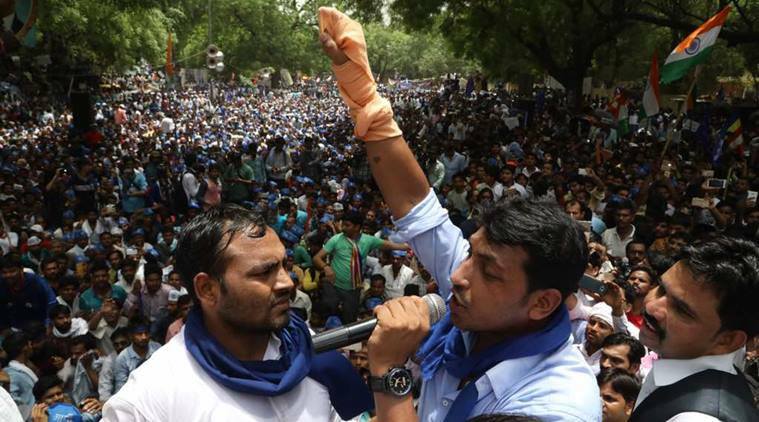Chandrashekhar and His Dalit Army Storm Delhi: Thousands Attend Meeting At Jantar Mantar

NEW DELHI: Bhim Army’s young leader Chandrashekhar emerged from hiding on Sunday to address a gathering of thousands who had gathered at Jantar Mantar Delhi to protest against the violence in Saharanpur. A massive mobilisation the meeting called for a struggle ahead for rights, with the charismatic lawyer saying that this was “our India” and the effort would be to keep her united.
He said that he had come prepared to surrender to the police that had been chasing him, and “was not a coward.” He had not turned himself in only because he wanted to speak to the people, to share what had happened, and what was going on, including the threats, the initimidation that the Dalits and the marginalised have been facing.
The gathering was the face of the youth, with the huge crowd enthusiastic and supportive and assertive as they repeatedly shouted “Jai Bhim.” Chandrashekhar showed his bruised hands, a result of beating by the cops in Saharanpur. He and a young friend Vinay Ratna Singh, both fresh graduates, wanted to do something for the most marginalised in society and just two years ago started a pathshala in Saharanpur, that grew in no time to nearly 400 such pathshalas spread across western UP. The success of their work was evident in the crowd that gathered at Jantar Mantar.
Chandrashekhar said that they believed in the Constitution of India, they wanted their solutions from within that framework but even so now they were being branded as Naxals by the government and the administration. This was because they were standing up for the rights of the Dalits. He concluded his speech with ‘sarfarosh ki tamanna’ the poem that was adopted by young leaders of the freedom struggle like Bhagat Singh.
The Bhim Army has now formally arrived, from a shadowy organisation as claimed by the authorities to a legitimate organisation, with young leaders inspired by the equality, rights and justice promised to all Indian citizens in the Indian Constitution. Chandrashekhar in his speech made it very clear that one, he was fired by equality for the Dalits and all marginalised sections; two, was wedded to the Constitution; three, respected the law but the law had to be applied fairly and without discrimination; and four, the marginalised should come together to demand their rights.



